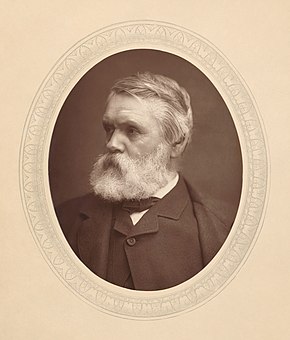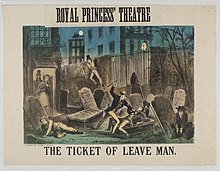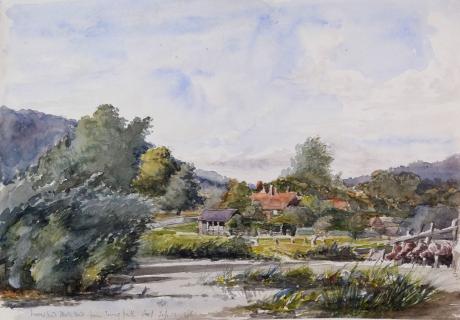inscribed and dated "Queens Head Mill End from Towing Path Sep 7 1861 Hambleden" and signed with initials "TT"
Tom and Laura Taylor and thence by descent
List of Publicans who ran the Queens Head Mill End Hambleden :
1847/Richard Cable/../../../Post Office Directory
1851/Richard Cable/Publican/48/Medmenham, Buckinghamshire/Census
1851/Sarah Cable/Wife/42/High Wycombe, Buckinghamshire/Census
1851/Owen Cable/Son/2/Hambleden, Buckinghamshire/Census
1851/Mary Ann Daston/General Servant/16/Fingest, Buckinghamshire/Census
1851/George Gray/Lodger, Ag Labourer, widow/49/Hambleden, Buckinghamshire/Census
1854/Richard Cable/& coal merchant/../../Kellys Directory
1861/Richard Cable/Inn Keeper/59/Medmenham, Buckinghamshire/Census
Mill End is the southern small hamlet in the civil parish on the main A4155 road between Henley-on-Thames and Marlow, by the River Thames. Mill End consists of 32 houses, some on the river bank and others on the northern side of the main road. The largest historic home is at the heart of its cluster of buildings, Yewden Manor, listed grade II for architecture.
The name clearly comes from the mill that is situated near the lock, on the fast-flowing, narrow, high-sided Hambleden Bourne, which discharges here. Mill End Farm, which has been run by the Bowden family since at least 1965, is opposite the lock and has farmed most of the land in and around the southern Hambleden area. This part of the Thames is characterised by willow trees and a large biodiversity of wildlife including swans, grebes, ducks, herons, terns and kingfishers. The footpath next to Hambleden Lock, the public towpath, provides a significant amenity to Mill End.
Anne Petrie, daughter of the famous Egyptian archaeologist Flinders Petrie lived in Mill End; she is buried in Hambleden church-yard.
In the Mill End part of the village are a watermill, lock and villa. Adjacent to the converted barns and the ordinary home named Mill House, which had served for centuries as home to the moderately wealthy miller of the district, is the much larger, often-photographed Hambleden Mill, which has been converted into flats; this is downstream of a pedestrianised weir from Hambleden Lock.
The site of an unusually immediately Thameside Roman villa adjoins the east of the development.
In Ridge Wood atop the hill opposite the village is a large avenue of giant sequoia and tall pine trees.
Henley Management College lies 0.6 miles (0.97 km) west and is also on the Thames.
Danesfield House, a hotel and spa is 2.4 miles (3.9 km) east of the village on a hillside of the same relatively steep bank.
Hambleden is a small village and civil parish in south-west Buckinghamshire, England. The village is around 4 miles (6.4 km) west of Marlow, and around 3 miles (4.8 km) north-east of Henley-on-Thames in Oxfordshire.
The civil parish also includes the villages of Fingest and Frieth, and the hamlets of Colstrope, Mill End, Parmoor, Pheasant's Hill and Skirmett. At the 2011 Census, the population of the parish was 1,445.


The village name is Anglo-Saxon in origin, and means 'crooked or irregularly-shaped hill'. It was recorded in the Domesday Book of 1086 as Hanbledene, though previously in 1015 it was known as Hamelan dene. St Thomas Cantilupe, the Lord Chancellor and Bishop of Hereford, was born in Hambleden in 1218. In 1315 a Royal charter was granted to hold a market in the village, and a fair on St Bartholomew's Day (24 August) every year. The charter was reconfirmed in 1321, though appears to have not lasted much longer than this.
The village was a base for US soldiers during the buildup to D-Day in 1944.
Hambleden was a large ancient parish, covering the area of the modern civil parish except for the village of Fingest. It extended over 6,598 acres (2,670 ha), stretching to Skirmett, 3 miles (4.8 km) north of the village of Hambleden, and Frieth 3 miles (4.8 km) north-east of the village. The ancient parish became a civil parish in 1866. In 1934 a small area in the north of the parish was transferred to the parish of Fingest and Lane End. In the 1980s the village of Fingest was added to the parish when the parish of Fingest and Lane End was abolished.
The brick and flint cottages in the centre of the village conform to a similar design and have dormer windows topped with red tiles. Saint Mary the Virgin's church dates from the 14th century and includes a conspicuous memorial to Cope D'Oyley (who died in 1633) and his family. The tower contains eight bells and the ceiling is quite intricately decorated in parts. The post office in the village serves also as the local shop and café.
The Elizabethan manor house opposite the church, formerly the home of Maria Carmela Viscountess Hambleden, was built in 1603 of flint and brick for Emanuel, 11th Baron Scrope, who became Earl of Sunderland. Charles I stayed there overnight in 1646 while fleeing from Oxford. The Manor House, Hambleden is also the former home of James Brudenell, 7th Earl of Cardigan who led the ill-fated Charge of the Light Brigade. Another notable (Listed Grade II*) building is Kenricks which overlooks the cricket ground and was the previous manor house and the home of Philadelphia Scrope, a cousin and Lady-in-Waiting to Queen Elizabeth I. On her death in 1627 it became The Rectory and was altered in 1724 by the Rector Rev Dr Scawen Kenrick. It ceased to be The Rectory in 1938 and was acquired by the 3rd Viscount Hambleden and renamed Kenricks.
Roman remains were unearthed to the south of the village in 1912. A contested theory was put forward by Jill Eyers from Chiltern Archaeology in 2010 that a military brothel might have formed part of the Yewden villa site, after archaeologists discovered skeletal remains of what appeared to be 97 newborn babies. The investigation features in the inaugural part of the archaeology series, Digging for Britain presented by Dr Alice Roberts. The first part of the second series promised to resolve some of the controversy.
Saint Thomas Cantilupe was born in the old Manor House (now Kenricks) in 1218. He became Chancellor of Oxford University, Bishop of Hereford and Lord Chancellor of England. He was canonised by Pope John XXII in 1320 and was the last Englishman to be canonised before the Reformation. Thomas D'Oylie (died 1603), physician and linguist, was the uncle of Sir Cope D'Oylie, whose memorial can be seen in St. Mary's Church. The Hambleden Estate was held by the Scrope family from 1365 to 1627. Philadelphia Carey, Lady Scrope was a granddaughter of Mary Boleyn, the sister of Queen Anne Boleyn who was executed by Henry VIII in 1536. The Estate was acquired in 1925 by Frederick Smith, 2nd Viscount Hambleden, who owned the adjoining Greenlands Estate. The Smith family sold the western part of the Estate in 2008 to the Swiss financier Urs Schwarzenbach. Major General Miles Fitzalan-Howard, 17th Duke of Norfolk, lived in the parish until his death in 2002 and his widow Anne continued to live there. Lord Cardigan, famous for his role in leading the ill-fated Charge of the Light Brigade, was born in the Manor House in 1797. The sea chest that he took to the Crimea can be seen in the church. Roger Marquis, 2nd Earl of Woolton lived at Kenricks in the 1960s. Musician Jon Lord, of Deep Purple, is buried in Saint Mary the Virgin's churchyard. Phil Vickery, Rugby Union London Wasps player and England 2003 World Cup Winner, lived in Hambleden

Tom Taylor (19 October 1817 – 12 July 1880) was an English dramatist, critic, biographer, public servant, and editor of Punch magazine. Taylor had a brief academic career, holding the professorship of English literature and language at University College, London in the 1840s, after which he practised law and became a civil servant. At the same time he became a journalist, most prominently as a contributor to, and eventually editor of Punch.
In addition to these vocations, Taylor began a theatre career and became best known as a playwright, with up to 100 plays staged during his career. Many were adaptations of French plays, but these and his original works cover a range from farce to melodrama. Most fell into neglect after Taylor's death, but Our American Cousin (1858), which achieved great success in the 19th century, remains famous as the piece that was being performed in the presence of Abraham Lincoln when he was assassinated in 1865.
Early years
Taylor was born into a newly wealthy family at Bishopwearmouth, a suburb of Sunderland, in north-east England. He was the second son of Thomas Taylor (1769–1843) and his wife, Maria Josephina, née Arnold (1784–1858). His father had begun as a labourer on a small farm in Cumberland and had risen to become co-owner of a flourishing brewery in Durham. After attending the Grange School in Sunderland, and studying for two sessions at the University of Glasgow, Taylor became a student of Trinity College, Cambridge in 1837, was elected to a scholarship in 1838, and graduated with a BA in both classics and mathematics. He was elected a fellow of the college in 1842 and received his MA degree the following year.

Taylor left Cambridge in late 1844 and moved to London, where for the next two years he pursued three careers simultaneously. He was professor of English language and literature at University College, London, while at the same time studying to become a barrister, and beginning his life's work as a writer. Taylor was called to the bar of the Middle Temple in November 1846. He resigned his university post, and practised on the northern legal circuit until he was appointed assistant secretary of the Board of Health in 1850. On the reconstruction of the board in 1854 he was made secretary, and on its abolition in 1858 his services were transferred to a department of the Home Office, retiring on a pension in 1876.
Writer
Taylor owed his fame and most of his income not to his academic, legal or government work, but to his writing. Soon after moving to London, he obtained remunerative work as a leader writer for the Morning Chronicle and the Daily News. He was also art critic for The Times and The Graphic for many years. He edited the Autobiography of B. R. Haydon (1853), the Autobiography and Correspondence of C. R. Leslie, R.A. (1860) and Pen Sketches from a Vanished Hand, selected from papers of Mortimer Collins, and wrote Life and Times of Sir Joshua Reynolds (1865). With his first contribution to Punch, on 19 October 1844, Taylor began a thirty-six year association with the magazine, which ended only with his death. During the 1840s he wrote on average three columns a month; in the 1850s and 1860s this output doubled. His biographer Craig Howes writes that Taylor's articles were generally humorous commentary or comic verses on politics, civic news, and the manners of the day. In 1874 he succeeded Charles William Shirley Brooks as editor.
Taylor also established himself as a playwright and eventually produced about 100 plays. Between 1844 and 1846, the Lyceum Theatre staged at least seven of his plays, including extravanzas written with Albert Smith or Charles Kenney, and his first major success, the 1846 farce To Parents and Guardians. The Morning Post said of that piece, "The writing is admirable throughout – neat, natural and epigrammatic". It was as a dramatist that Taylor made the most impression – his biographer in the Dictionary of National Biography (DNB) wrote that in writing plays Taylor found his true vocation. In thirty-five years he wrote more than seventy plays for the principal London theatres.

A substantial portion of Taylor's prolific output consisted of adaptations from the French or collaborations with other playwrights, notably Charles Reade. Some of his plots were adapted from the novels of Charles Dickens or others. Many of Taylor's plays were extremely popular, such as Masks and Faces, an extravaganza written in collaboration with Reade, produced at the Haymarket Theatre in November 1852. It was followed by the almost equally successful To Oblige Benson (Olympic Theatre, 1854), an adaptation from a French vaudeville. Others mentioned by the DNB are Plot and Passion (1853), Still Waters Run Deep (1855) and The Ticket-of-Leave Man (based on Le Retour de Melun by Édouard Brisebarre and Eugène Nus), a melodrama produced at the Olympic in 1863.Taylor also wrote a series of historical dramas (many in blank verse), including The Fool’s Revenge (1869), an adaption of Victor Hugo's Le roi s'amuse (also adapted by Verdi as Rigoletto), 'Twixt Axe and Crown (1870), Jeanne d'arc (1871), Lady Clancarty (1874) and Anne Boleyn (1875). The last of these, produced at the Haymarket in 1875, was Taylor's penultimate piece and only complete failure. In 1871 Taylor supplied the words to Arthur Sullivan's dramatic cantata, On Shore and Sea.
Like his colleague W. S. Gilbert, Taylor believed that plays should be readable as well as actable; he followed Gilbert in having copies of his plays printed for public sale. Both authors did so at some risk, because it made matters easy for American pirates of their works in the days before international copyright protection. Taylor wrote, "I have no wish to screen myself from literary criticism behind the plea that my plays were meant to be acted. It seems to me that every drama submitted to the judgment of audiences should be prepared to encounter that of readers".

Many of Taylor's plays were extremely popular, and several survived into the 20th century, although most are largely forgotten today. His Our American Cousin (1858) is now remembered chiefly as the play Abraham Lincoln was attending when he was assassinated, but it was revived many times during the 19th century with great success. It became celebrated as a vehicle for the popular comic actor Edward Sothern, and after his death, his sons, Lytton and E. H. Sothern, took over the part in revivals.
Howes records that Taylor was described as "of middle height, bearded [with] a pugilistic jaw and eyes which glittered like steel". Known for his remarkable energy, he was a keen swimmer and rower, who rose daily at five or six and wrote for three hours before taking an hour's brisk walk from his house in Wandsworth to his Whitehall office.
Some, like Ellen Terry, praised Taylor's kindness and generosity; others, including F. C. Burnand, found him obstinate and unforgiving. Terry wrote of Taylor in her memoirs:
Most people know that Tom Taylor was one of the leading playwrights of the 'sixties as well as the dramatic critic of The Times, editor of Punch, and a distinguished Civil Servant, but to us he was more than this. He was an institution! I simply cannot remember when I did not know him. It is the Tom Taylors of the world who give children on the stage their splendid education. We never had any education in the strict sense of the word yet through the Taylors and others, we were educated.
Terry's frequent stage partner, Henry Irving said that Taylor was an exception to the general rule that it was helpful, even though not essential, for a dramatist to be an actor to understand the techniques of stagecraft: "There is no dramatic author who more thoroughly understands his business".
In 1855 Taylor married the composer, musician and artist Laura Wilson Barker (1819–1905). She contributed music to at least one of his plays, an overture and entr'acte to Joan of Arc (1871), and harmonisations to his translation Ballads and Songs of Brittany (1865). There were two children: the artist John Wycliffe Taylor (1859–1925) and Laura Lucy Arnold Taylor (1863–1940). Taylor and his family lived at 84 Lavender Sweep, Battersea, where they held Sunday musical soirees. Celebrities who attended included Lewis Carroll, Charles Dickens, Henry Irving, Charles Reade, Alfred Tennyson, Ellen Terry and William Makepeace Thackeray.
Taylor died suddenly at his home in 1880 at the age of 62 and is buried in Brompton Cemetery. After his death, his widow retired to Coleshill, Buckinghamshire, where she died on 22 May 1905.

